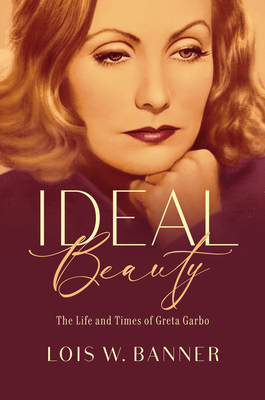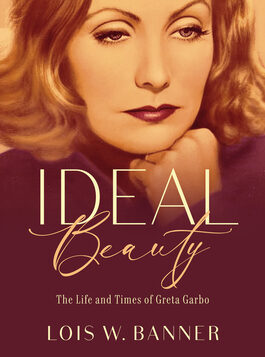 IDEAL BEAUTY
IDEAL BEAUTY
The Life and Times of Greta Garbo
by Lois W. Banner
Rutgers Univ. Press. 286 pages, $34.95
CELEBRITIES who retreat from the public eye become all the more intriguing because of their aura of inaccessibility. Greta Garbo retired from the screen at 35 and led a secluded life until she died in 1990. She made 28 movies in her career and acquired the status of Hollywood royalty. I’m guessing whether most of Generations X, Y, and Z have ever heard of this goddess or seen one of her films unless they’re hardcore TCM fans or aspiring actors or film critics. A few more may be familiar with the phrase that defined her in the media and was often misquoted: “I want to be alone.” (The actual quote was: “I want to be let alone.”) But that was impossible, because MGM, run by Louis B. Mayer and “boy genius” Irving Thalberg, had brought European actresses like Garbo and Marlene Dietrich to America and chosen films for them expressly to make money.
A new biography, Ideal Beauty: The Life and Times of Greta Garbo, by feminist historian Lois Banner—who’s the cofounder of the Berkshire Conference of Women Historians—presents Greta Louisa Gustafson (1905–1990) as Dr. Jekyll and Ms. Hyde. So much has been written about the actress that the Hollywood dream factory exploited as a marketable commodity during the 1920s and ’30s, when Garbo was billed as “the most beautiful woman in the world,” that it’s a challenge to say something new. Banner’s book offers a feminist rehash of Garbo’s childhood and reprises the well-known struggles on her quest for cinematic fame and financial freedom.
From the beginning, Garbo used the acting skills that she had mastered in Sweden and Germany to establish a performative persona that the camera loved. Her facial assets included a pale complexion, large and intense eyes, deep-set lids, high cheekbones, long eyelashes, and expressive lips. Her acting was most effective in her silent films and, later, in talking pictures like Eugene O’Neill’s Anna Christie, which opens with Garbo’s first spoken lines: “Gimme a whiskey—ginger ale on the side—and don’t be stingy, baby.” The publicity department advertised the film with the tagline: “Garbo Talks.”

A consummate performer, she was an expert at milking silent pauses for all they were worth. She played a variety of aristocrats, femme fatales, whores, and working-class girls throughout her career. Many of her heroines were women with regular jobs who faced challenges with wit, perseverance, and strength. Her most popular silent and talking films included Flesh and the Devil, Anna Christie, Grand Hotel, Queen Christina, Camille, and Ninotchka. MGM Studios and Hollywood gossip columnists Louella Parsons and Hedda Hopper sold Garbo to eager readers who were primarily white, middle- to upper-class women who aspired to upward mobility as depicted in films and fashions.
Banner demonstrates that Garbo was a new kind of star who displaced the petite, simpering American film models that Mayer and Thalberg had created. Tall (at five-foot-six), thin, and androgynous, she exemplified a new kind of woman with her distinctive appearance, a sort of old-money, timeless, minimalist style consisting of handmade oxfords crafted especially for her in London, man-tailored jackets, long, elegant camel coats, pleated trousers, and a butch stride that screamed independence.
This woman was a far cry from the poor girl living in a cramped apartment with no indoor plumbing in one of Stockholm’s poorest neighborhoods. Garbo told interviewers that her mother was practical and non-demonstrative. Her father, an unskilled laborer, was handsome, musical, and fun. In fact, she adored him, but he developed a life-threatening kidney infection. Greta went with him from hospital to hospital, unable to afford life-saving treatments in time. She was fourteen when he died, leaving the family impoverished. They lived hand-to-mouth for most of her childhood. Like a character in a Dickens novel, she never forgot the humiliations she and her family experienced. She dropped out of school and went to work at a barbershop, where she applied shaving cream to men’s faces, and then found work at a department store where she sold hats. As a teenager, she longed to be an actress and appeared in an advertising film for the department store at age fifteen.
Two years later, she attended the prestigious Royal Dramatic Theatre in Sweden, where she learned the semiotics of movement, gesture, and expression. Her break came in 1923 when the gay, Jewish director Mauritz Stiller needed an actress for an epic based on the Swedish novel The Story of Gosta Berling. Seeing her potential, he chose Garbo and soon became something of a Svengali figure to her. Next, while scouting for European talent, Louis Mayer invited Stiller and his untested starlet to Hollywood. The director sold himself and Garbo to the studio as a package deal. They sailed to the U.S. in 1925, arriving in New York, where Garbo loved riding the rollercoaster at Coney Island. Next, they boarded the train to Hollywood.
Garbo’s first two pictures were hits; in Torrent and The Temptress (both 1926), she showcased the European “femme fatale” as elaborated by the great German director Fritz Lang in Metropolis and popularized by Louise Brooks in Pandora’s Box (both 1929). For gay and especially lesbian fans, Garbo’s most memorable talking part is the title role in Queen Christina (1933), written by Salka Viertel, a bisexual actress, Jewish refugee, and former Garbo lover turned screenwriter. Viertel convinced Thalberg to cast Garbo, who loved the role of Christina because, like the writer Daphne de Maurier, she could “let her boy out of the box.” In the final scene, the androgynous Swedish ruler stands at the prow of a ship, the wind blowing her hair away to reveal those perfect features as she hurtles away from her country and her dead lover into the unknown.
In her private life, Garbo’s closet was full of mannish suits, shirts, and ties. She often called herself a “fellow” and signed her letters “Harry Boy.” But Banner’s feminist analysis does little to shed fresh light on Garbo the person as distinct from Garbo the legend, perhaps because of the author’s own need to emphasize her subject’s bisexuality rather than her well-documented lesbianism. As for Garbo’s withdrawal from the public, it most likely stemmed from a variety of physical and mental health challenges that were largely unexamined by the actress. Her social phobias were severe, debilitating, and not conducive to maintaining close or enduring relationships. She never felt truly at home in America. After retiring from the movies, she eventually settled in New York City and made it her home base.
Garbo never married or had children. She had numerous crushes on and love affairs with women, including several serious relationships, in addition to some physical relationships with men who cared for her. Banner concurs with Robert Gottlieb, Garbo’s most sympathetic biographer, that she faced multiple psychological and health challenges all her life. Eventually, she became uncomfortable with the very celebrity that she had so eagerly sought.
Why Garbo gave up acting and removed herself from public view, besides being savvy about marketing her brand, remains an unsolved riddle that no biographer has fully answered. Banner suggests that it may have been because some gossip columnists declared Garbo to be box office poison. But she was nominated for Best Actress by the Academy four times, including for her 1939 hit film Ninotchka. In the end, behind the mask was a sad and self-absorbed woman who found herself living a dream life among the international jet set. Her understated performances allowed audiences to project their own emotions onto the blank canvas of her flawless face, which accounts for much of her popularity. It lasted until the film noir femme fatales and career women of the 1940s came along to displace her.
Cassandra Langer is the author of the 2023 memoir Erase Her: A Survivor’s Story.






